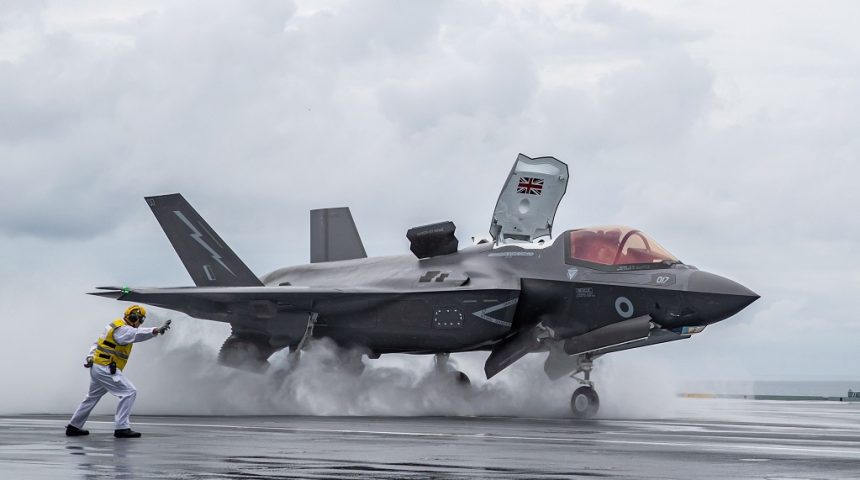The aircraft went down soon after takeoff this morning while the HMS Queen Elizabeth was sailing in the Eastern Mediterranean Sea. Probably, recovery operation underway.
As you may know by now, a British F-35B crashed in the Mediterranean Sea on Nov. 17, 2021, around 10AM GMT. The aircraft was one of the eight British F-35s and ten U.S. Marine Corps F-35s currently embarked aboard the HMS Queen Elizabeth aircraft carrier. A very short statement by the UK Ministry of Defence Press Office, released this afternoon, stated that the pilot was rescued and returned to the ship following a successful ejection.
Defence Secretary Ben Wallace, as quoted by BBC’s Defence Correspondent Jonathan Beale, provided some further details, saying that the F-35 ditched soon after taking off from the aircraft carrier and that operational and training flights onboard HMS Queen Elizabeth are continuing despite the incident. Some reports mentioned the possibility of a British pilot flying on a US jet, however it has been later confirmed that both the pilot and the F-35B were indeed British.
More on #F35 crash:The Defence Secretary Ben Wallace said The F35 jet ditched soon after take off . He said “we are pleased the pilot is safe and well and back on board. Mr Wallace said operational and training flights on board HMS QE carrier are continuing despite the incident
— Jonathan Beale (@bealejonathan) November 17, 2021
NEW: @FCDOGovUK reveals more details about British pilot who ejected from an F-35 over the Mediterranean earlier today.
Pilot returned to HMS Queen Elizabeth, investigation begun. Pilot is British, was flying a British plane. No other aircraft involved. 1/
— Paul D. Shinkman (@PDShinkman) November 17, 2021
The HMS Queen Elizabeth is currently on her way back to the UK from the maiden operational deployment with the recently established Carrier Strike Group. The 28-week deployment, which has been dubbed Carrier Strike Group 2021, brought the British aircraft carrier to the troubled waters of the Indo-Pacific region as the flagship of the largest naval and air task force under British command since the Falklands war. The CSG was planned to visit 40 nations during the 26,000-nautical-mile cruise.
Naval AIS (Automatic Identification Systems) data showed the HMS Queen Elizabeth CSG passing through the Suez Canal during yesterday’s afternoon, as seen on multiple ship tracking websites like MarineTraffic. The info was also confirmed by satellite imagery. This restricts the area where the mishap happened to the area between Egypt, Cyprus and Crete. If the ship was to make a port call in Cyprus like it did in July before moving to the Red Sea, this would restrict even more the area that needs to be considered.
The Queen Elizabeth CSG passed through the Suez Canal, northbound.
The ships visible through AIS:
HNLMS Evertsen(F805)
RFA Tidespring(A136)
RFA Fort Victoria(A387)
A 4th spoofing ship, possibly HMS Queen Elizabeth(R08) pic.twitter.com/U9LfN6U1mj
— Nick (@n_morse9927) November 16, 2021
The satellite captured the Queen Elizabeth @HMSQNLZ returning to the Mediterranean for training#OSINT #CSG21 https://t.co/y3cAwx4Y4l pic.twitter.com/otkxOfRg0l
— GEOINT (@lobsterlarryliu) November 17, 2021
In either case, the F-35 wreck on the Mediterranean seafloor is quite a sensitive matter, as the area where the mishap happened is relatively close to the Russian bases in Syria. This crash sparks concerns similar to the ones that followed the crash of a Japanese F-35 in 2019, when reports mentioned the risks of Russian and Chinese units trying to recover the missing fuselage in the attempt to exploit its remains to gather intelligence about the F-35’s low observable and sensor technology.
In that occasion, the F-35 crashed in an area about 130 km from Misawa AB where the water depth was deemed to be about 10,000 feet. This might also be similar to yesterday’s crash, as it happened in open water with depths that can exceed, in some areas, over 3,000 meters, which correspond to about 10,000 feet. The area is also highly trafficked, given the proximity to the Suez Canal, and combined with the extreme depth, this reduces the chances of another country finding and exploiting any of the plane’s remains.
Even if someone succeeded, it is unlikely to gather useful data, as we wrote in a previous article here at The Aviationist:
“It could present problems depending on what is recovered, when it is recovered and, above all, in which conditions, after impacting the surface of the water,” our own David Cenciotti told Fox News via email. “The F-35 is a system of systems and its Low Observability/stealthiness is a system itself. It is obtained with a particular shape of the aircraft, a certain engine and the use of peculiar materials and systems all those are managed and tightly integrated by million lines of software code: this means that it would be extremely difficult to reverse engineer the aircraft by recovering debris and broken pieces from the ocean bed. However, there are still lots of interesting parts that could be studied to get some interesting details: a particular onboard sensor or something that can’t be seen from the outside but could be gathered by putting your hands on chunks of the aircraft intakes or exhaust section, on the radar reflectors etc.”
Yesterday’s F-35 mishap should be the sixth where the aircraft has been lost since it entered service, and the first non-US B-model crash. As of today, the list counts two US and one Japanese F-35A and two US and one British F-35B. Before the crash, the UK had 24 F-35Bs delivered, of which three in the USA for testing, eight on the HMSQE and the remaining ones at RAF Marham.
Glad to hear the pilot of the 617 Sqn F-35B is safe. This is understood to be the first non-US loss of an F-35B, the type is currently only operated by the UK, U.S. Marines and the Italian Navy.
— Tony Osborne (@Rotorfocus) November 17, 2021









